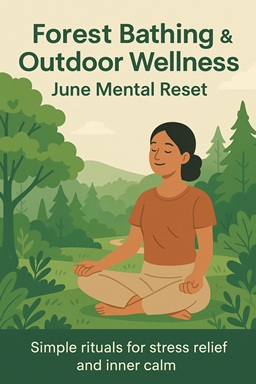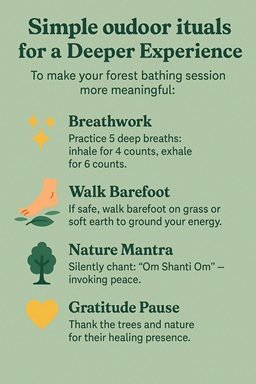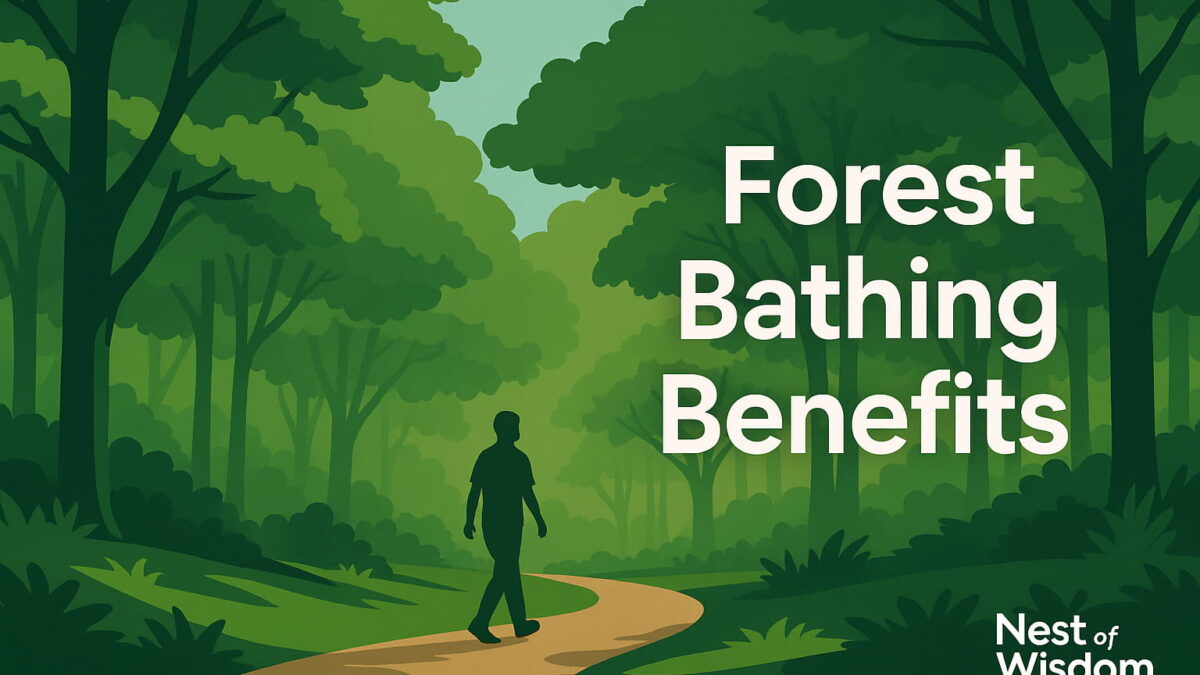Table of Contents
- Introduction: Why Forest Bathing Benefits Matter
- What Is Forest Bathing (Shinrin-yoku)?
- 12 Forest Bathing Benefits (Science-Backed)
- The Science in Simple Terms
- How to Practice: A Gentle 30-Minute Session
- Outdoor Rituals to Deepen the Experience
- Safety & Seasonal Tips
- Seasonal Guide: Summer, Monsoon, Autumn & Winter
- Urban & Apartment-Friendly Ideas
- Family, Kids & Older Adults
- Make It a Habit: 7-Day Starter Plan
- Common Mistakes & Simple Fixes
- Can’t Go Outside? Indoor Nature Reset
- FAQ: Forest Bathing Benefits
- Related Posts on NestOfWisdom
- References (Authoritative Sources)
- Conclusion
Introduction: Why Forest Bathing Benefits Matter


Forest bathing benefits go beyond a pleasant stroll. This unhurried, mindful time in green spaces can calm the nervous system, steady your mood, and sharpen your focus. You don’t need remote wilderness—tree-lined streets, urban parks, lakeside paths, or botanical gardens all deliver the core forest bathing benefits when you combine slow breathing with curious, gentle attention.
தமிழ்: “இயற்கையுடன் சில நிமிடங்கள் — மனதுக்கு பெரிய ஓய்வு.” (Iyarkkaiyudan sila nimidangal — manathukku periya oyvu.)
What Is Forest Bathing (Shinrin-yoku)?
Originating in Japan, Shinrin-yoku translates to “forest bath.” It is not a hike for speed or steps but a sensory immersion: notice light through leaves, textures of bark, and the rhythm of your breath. That shift from doing to sensing is what unlocks the most reliable forest bathing benefits: lower stress, clearer thinking, and a refreshed, grounded body.
Unlike goal-driven exercise, this practice invites a soft, open awareness. You pause. You breathe. You let sights and sounds arrive without judging or naming them. Five minutes is good; 20–30 minutes is often enough to feel a reset.
தமிழ்: “காட்டின் அமைதியில் மனம் நிம்மதியடையும்.” (Kaattin amaithiyil manam nimmathiyadaium.)
12 Forest Bathing Benefits (Science-Backed)
Modern research echoes traditional wisdom: nature heals. Here are twelve essential forest bathing benefits you can cultivate with regular practice:
- Stress relief: Time among trees is associated with lower cortisol and calmer heart-rate variability.
- Anxiety ease: Slow breathing and gentle attention reduce the mental “noise” that fuels worry.
- Mood lift: Regular nature walks correlate with fewer depressive symptoms and more positive affect.
- Sharper focus: “Soft fascination” in nature rests the prefrontal cortex, restoring attention.
- Better sleep: Evening sessions help downshift, making deeper rest more likely.
- Immune support: Forest air contains phytoncides linked to increased natural-killer (NK) cell activity.
- Blood pressure balance: Gentle walking plus calm breathing can support healthier readings over time.
- Pain perception: Mindful sensory focus may reduce perceived pain or tension.
- Creativity boost: A quieter mind invites insight, idea linking, and novel solutions.
- Social connection: Shared green-space walks strengthen bonds without screens or agendas.
- Mind–body awareness: Reconnecting with breath and senses improves interoception (body signals).
- Everyday resilience: Small, repeated sessions train a steadier baseline—useful on busy weeks.
தமிழ்: “சூழலின் சக்தியை உணருங்கள்.” (Soozhalin sakthiyai unarungal.)
The Science in Simple Terms
Three ideas explain why forest bathing benefits are so reliable:


Nervous system reset: Natural settings nudge your body from “fight or flight” (sympathetic) toward “rest and digest” (parasympathetic). You may notice slower breathing, a softer gaze, and fewer racing thoughts. This shift often shows up as steadier heart-rate variability (HRV) and a general sense of ease.
Attention Restoration Theory (ART): City life demands “hard focus” (emails, alerts, traffic). In nature, “soft fascination” takes over—your attention is held gently by patterns like leaves or water ripples. This lets your directed attention rest and refill, improving concentration later.
Phytoncides & immunity: Trees release aromatic compounds (phytoncides). Breathing them during slow walks has been linked to transient boosts in natural-killer (NK) cell activity—your immune system’s first responders. The effect is modest but meaningful when sessions are consistent.
Put simply: your body downshifts, your mind refuels, and your immune tone gets a nudge. That’s the everyday magic behind forest bathing benefits.
தமிழ்: “இயற்கை உடல்–மன அமைதியை மீட்டளிக்கும்.”
How to Practice: A Gentle 30-Minute Session
You don’t need hours. A simple half-hour can deliver the core forest bathing benefits:
- Arrive (3 minutes): Phone on airplane mode. Stand still. Notice temperature on your cheeks, air on your palms.
- Breath sync (2 minutes): Inhale 4 counts, exhale 6 counts. Shoulders drop; jaw softens.
- Sensory walk (15 minutes): Stroll slowly. Scan for colors, leaf shapes, bark textures, birdsong, light and shadow. Let thoughts pass like clouds.
- Sit spot (5 minutes): Find a bench or rock. Observe without labeling; receive sights and sounds.
- Gratitude close (5 minutes): Hand on heart. Thank the space for its care and set a gentle intention for the next hour.
தமிழ்: “இது மனதுக்கு ஓய்வளிக்கும் நேரம்.” (Idhu manathukku oyvalikkum neram.)
Outdoor Rituals to Deepen the Experience


Add one small ritual to anchor the forest bathing benefits in memory:
- Grounding: If safe, place both palms on a tree trunk for 60–90 seconds; notice warmth, texture, and breath.
- Breath mantra: Silently repeat “In: calm, Out: release.”
- Micro-journaling: Record three words for sight, sound, and scent; this tiny log nudges you to return.
- Gratitude: Name one way nature supported you today (shade, birdsong, quiet path).
தமிழ்: “அமைதியை உள்ளே அழைத்து, அழுத்தத்தை வெளியே விடுங்கள்.”
Safety & Seasonal Tips
- Check weather and daylight; favor shaded routes in warm seasons.
- Hydrate; wear a hat and sunscreen when needed. Use repellent where bugs are active.
- Know your allergies (pollen/grass). Carry what you need.
- Prefer familiar paths; tell someone if you’re going alone.
- Respect local guidelines and wildlife; practice leave-no-trace.
தமிழ்: “பாதுகாப்பே முதன்மை.” (Paadhukaappe mudhanmai.)
Seasonal Guide: Summer, Monsoon, Autumn & Winter
Different seasons highlight different forest bathing benefits. Adjust the practice so you stay comfortable and consistent:
Summer / Heat
- When: Early morning or late evening for gentle light and cooler air.
- Where: Shaded avenues, lakeshore paths, botanical gardens with canopy cover.
- How: Shorter sessions (15–20 minutes) with extra hydration and light clothing. Seek breeze corridors.
Monsoon / Rain
- When: Light rain or post-shower; avoid lightning and high winds.
- Where: Stable, non-slippery paths with good drainage; covered walkways in tree-rich campuses.
- How: Embrace scent and sound—petrichor, raindrops on leaves. Waterproof footwear, slow steps.
Autumn
- When: Golden hour to soak in color gradients.
- Where: Parks with deciduous trees, arboretums.
- How: Focus on color scanning and leaf textures; collect three fallen leaves (leave the rest).
Winter / Cold
- When: Midday for warmth and safer footing.
- Where: Plowed park loops, conifer groves that soften wind.
- How: Layer clothing, warm beverage after. Listen for crisp sounds—snow crunch, quiet branches.
தமிழ்: “துக்களுக்கு ஏற்ப வழக்கத்தை மாற்றுங்கள்.” (Ruthukkalukku yerpa vazhakkathai maatruṅgaḷ.)
Urban & Apartment-Friendly Ideas
City life doesn’t cancel forest bathing benefits. Try these options when a big park is far:
- Micro-greenspaces: Courtyards, community gardens, riverside promenades, or quiet medians with shade trees.
- Green corridors: Walk along streets with mature trees; notice repeating canopies and birdsong pockets.
- Botanical gardens: Even short, ticketed visits provide concentrated sensory variety.
- Balcony plants: A cluster of aromatic herbs (mint, basil, rosemary) offers scent-based calm on busy days.
தமிழ்: “நகரிலும் இயற்கையை காணலாம்.” (Nagarilum iyarkkaiyai kaanalaam.)
Family, Kids & Older Adults
Invite loved ones and adapt the practice to comfort and safety:
- Kids: Turn the sensory walk into a game: “find three leaf shapes,” “count two bird calls.” Keep it playful.
- Older adults: Choose flat paths, benches at intervals, and shade. Five minutes sitting among trees still brings forest bathing benefits.
- Accessibility: Many parks now have paved, wheelchair-friendly loops with rest areas and accessible bathrooms.
தமிழ்: “ஒவ்வொருவரும் அவரவர் வேகத்தில்.” (Ovvoruvarum avaravar vegathil.)
Make It a Habit: 7-Day Starter Plan
Consistency unlocks compounding forest bathing benefits. Try this week-long ramp:
- Day 1 — Two trees: Visit the closest green spot. Five slow minutes. Done.
- Day 2 — Breath sync: Six rounds of 4-in/6-out while walking.
- Day 3 — Colors & textures: Name three greens and two textures you can see.
- Day 4 — Sit spot: Three minutes stillness. Eyes soften; jaw unclenches.
- Day 5 — Gratitude log: One sentence about how you feel after the walk.
- Day 6 — Longer loop: Add five minutes to your route.
- Day 7 — Share it: Invite a friend; compare what each of you noticed.
தமிழ்: “தினசரி சிறு நடை — மன அமைதி பெரிய பலன்.”
Common Mistakes & Simple Fixes
- Going too fast: If you catch yourself rushing, pause and count one full breath before each step for ten steps.
- Screen distraction: Airplane mode is your ally. Photograph at the end, not during.
- Labeling everything: Try “soft eyes.” Let shapes and sounds arrive without naming.
- All-or-nothing: Ten minutes is enough on busy days. Small sessions still build forest bathing benefits.
- No follow-through: Put two standing slots on your calendar (e.g., Wed/Sun sunset walk).
Can’t Go Outside? Indoor Nature Reset
Some days the weather or schedule won’t cooperate. You can still get partial forest bathing benefits with a short indoor reset:
- Window green: Sit facing a tree canopy or potted plant; rest your gaze on shapes for two minutes.
- Nature sound: Play a gentle forest soundscape; breathe 4-in/6-out for five rounds.
- Scent anchor: Use a drop of cedar or pine essential oil (if safe) to cue calm and memory of the outdoors.
- Micro-visualization: Eyes closed, imagine dappled light on leaves and the smell of wet soil after rain.
தமிழ்: “வீட்டிலும் இயற்கை உணர்வு சாத்தியம்.” (Veettilum iyarkkai unarvu saathiyam.)
FAQ: Forest Bathing Benefits
Do I need a forest to get forest bathing benefits?
No. Any green space works—parks, gardens, lakesides, and tree-lined streets. The key is slow, sensory attention.
How often should I practice?
Start with 2–3 sessions per week (20–30 minutes). Many people feel benefits even from short 10-minute walks.
Can I listen to music or podcasts?
For the full forest bathing benefits, keep audio off. Let natural soundscapes reset your attention.
Is it safe for beginners or older adults?
Yes—choose flat, safe paths, comfortable footwear, and daylight hours. Consult a clinician if you have medical concerns.
Related Posts on NestOfWisdom
- Best Yoga Poses for Stress Relief (with Tamil Names)
- Best Herbal Teas for Better Sleep
- Best Ayurvedic Remedies vs Modern Remedies
- Diabetic Friendly Indian Breakfast Recipes
References (Authoritative Sources)
- Harvard T.H. Chan School of Public Health — Boost your mental health by spending time outside
- Harvard T.H. Chan School of Public Health — Spend time outdoors. It’ll improve your health, say experts.
- Harvard Chan News — Time spent in nature can boost physical and mental well-being
- Association of Nature & Forest Therapy — Research: Science-based benefits of forest bathing
- NIH / PMC — Effect of forest bathing trips on human immune function (Li, 2009)
- NIH / PMC — Effects of forest environment on health promotion (Li, 2022 review)
- NIH / PMC — Health effects of a forest environment on natural killer cells (Tsao, 2018)
Conclusion
When practiced gently and often, forest bathing benefits stack up: a quieter mind, steadier energy, and more restorative sleep. Choose an easy path, slow your breath, and let attention rest on living green. Small, regular sessions turn nature into your most reliable reset button.
Nest of Wisdom Insights is a dedicated editorial team focused on sharing timeless wisdom, natural healing remedies, spiritual practices, and practical life strategies. Our mission is to empower readers with trustworthy, well-researched guidance rooted in both Tamil culture and modern science.
இயற்கை வாழ்வு மற்றும் ஆன்மிகம் சார்ந்த அறிவு அனைவருக்கும் பயனளிக்க வேண்டும் என்பதே எங்கள் நோக்கம்.
- Nest of Wisdom Insightshttps://nestofwisdom.com/author/nestofwisdom/
- Nest of Wisdom Insightshttps://nestofwisdom.com/author/nestofwisdom/
- Nest of Wisdom Insightshttps://nestofwisdom.com/author/nestofwisdom/
- Nest of Wisdom Insightshttps://nestofwisdom.com/author/nestofwisdom/
Related posts
Today's pick
Recent Posts
- Internal Linking Strategy for Blogs: A Practical, Human-Centered Playbook
- AI in the Automotive Industry: A Practical, Human-Centered Guide
- Cloud Tools for Small Businesses and Freelancers: The Complete Guide
- Generative AI in Business: Real-World Use Cases, Benefits & Risks
- 7 Life-Changing Daily Habits for Weight Loss Without Dieting


